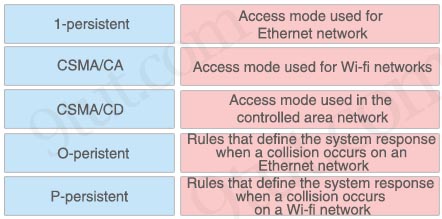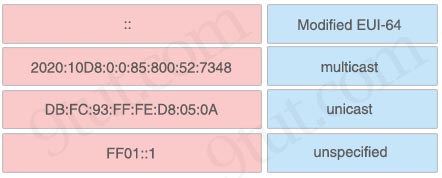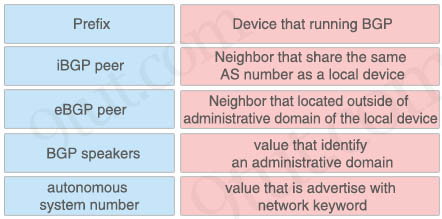Drag and Drop 4
Question 1
Question 2
Explanation
The control plane: The control plane is the brain of the router. It consists of dynamic IP routing protocols (that is OSPF, IS-IS, BGP, and so on), the RIB, routing updates, in addition to other protocols such as PIM, IGMP, ICMP, ARP, BFD, LACP, and so on. In short, the control plane is responsible for maintaining sessions and exchanging protocol information with other router or network devices.
The data plane: The data plane is the forwarding plane, which is responsible for the switching of packets through the router (that is, process switching and CEF switching). In the data plane, there could be features that could affect packet forwarding such as quality of service (QoS) and access control lists (ACLs).
Reference: http://www.ciscopress.com/articles/article.asp?p=2272154&seqNum=3
Question 3
Explanation
The “T” letter symbolizes for “twisted pair cable” so all “BASE-T…” types are copper.
Question 4
Question 5
Question 6
Question 7
Explanation
Minimum Time to Live: The TTL value for the first probes. The default is 1, but it can be set to a higher value to suppress the display of known hops.
Numeric display: The default is to have both a symbolic and numeric display; however, you can suppress the symbolic display.
Question 8
Question 9
Question 10
Drag and drop the CSMA components from the left onto the correct descriptions on the right

Answer:
+ 1-persistent: Access mode used for Ethernet network
+ CSMA/CA: Rules that define the system response when a collision occurs on a Wi-fi network
+ CSMA/CD: Rules that define the system response when a collision occurs on an Ethernet network
+ O-peristent: Access mode used in the controlled area network
+ P-persistent: Access mode used for Wi-fi networks
Explanation
1-persistent CSMA is an aggressive transmission algorithm. When the transmitting node is ready to transmit, it senses the transmission medium for idle or busy. If idle, then it transmits immediately. If busy, then it senses the transmission medium continuously until it becomes idle, then transmits the message (a frame) unconditionally (i.e. with probability=1). In case of a collision, the sender waits for a random period of time and attempts the same procedure again. 1-persistent CSMA is used in CSMA/CD systems including Ethernet.
Non persistent CSMA is a non aggressive transmission algorithm. When the transmitting node is ready to transmit data, it senses the transmission medium for idle or busy. If idle, then it transmits immediately. If busy, then it waits for a random period of time (during which it does not sense the transmission medium) before repeating the whole logic cycle (which started with sensing the transmission medium for idle or busy) again. This approach reduces collision, results in overall higher medium throughput but with a penalty of longer initial delay compared to 1–persistent.
P-persistent is an approach between 1-persistent and non-persistent CSMA access modes. [1]When the transmitting node is ready to transmit data, it senses the transmission medium for idle or busy. If idle, then it transmits immediately. If busy, then it senses the transmission medium continuously until it becomes idle, then transmits with probability p. If the node does not transmit (the probability of this event is 1-p), it waits until the next available time slot. If the transmission medium is not busy, it transmits again with the same probability p. This probabilistic hold-off repeats until the frame is finally transmitted or when the medium is found to become busy again (i.e. some other node has already started transmitting). In the latter case the node repeats the whole logic cycle (which started with sensing the transmission medium for idle or busy) again. p-persistent CSMA is used in CSMA/CA systems including Wi-Fi and other packet radio systems.
O-persistent
Each node is assigned a transmission order by a supervisory node. When the transmission medium goes idle, nodes wait for their time slot in accordance with their assigned transmission order. The node assigned to transmit first transmits immediately. The node assigned to transmit second waits one time slot (but by that time the first node has already started transmitting). Nodes monitor the medium for transmissions from other nodes and update their assigned order with each detected transmission (i.e. they move one position closer to the front of the queue).[2] O-persistent CSMA is used by CobraNet, LonWorks and the controller area network.
Reference: https://en.wikipedia.org/wiki/Carrier-sense_multiple_access
Question 11
Drag and drop the IPv6 addresses from the left onto the correct types on the right

Answer:
+ Modified EUI-64: DB:FC:93:FF:FE:D8:05:0A
+ multicast: FF01::1
+ unicast: 2020:10D8:0:0:85:800:52:7348
+ unspecified: ::
Question 12
Drag and drop the BGP components from the left onto the correct descriptions on the right.

Answer:
+ Device that running BGP: BGP speakers
+ Neighbor that share the same AS number as a local device: iBGP peer
+ Neighbor that located outside of AD domain of the local device: eBGP peer
+ Value that identify an administrative domain: Autonomous system number
+ Value that is advertise with network keyword: Prefix


